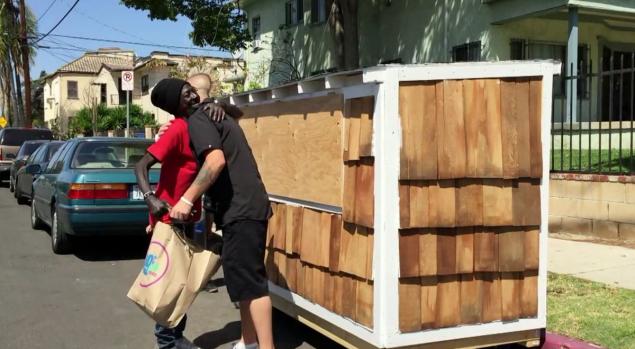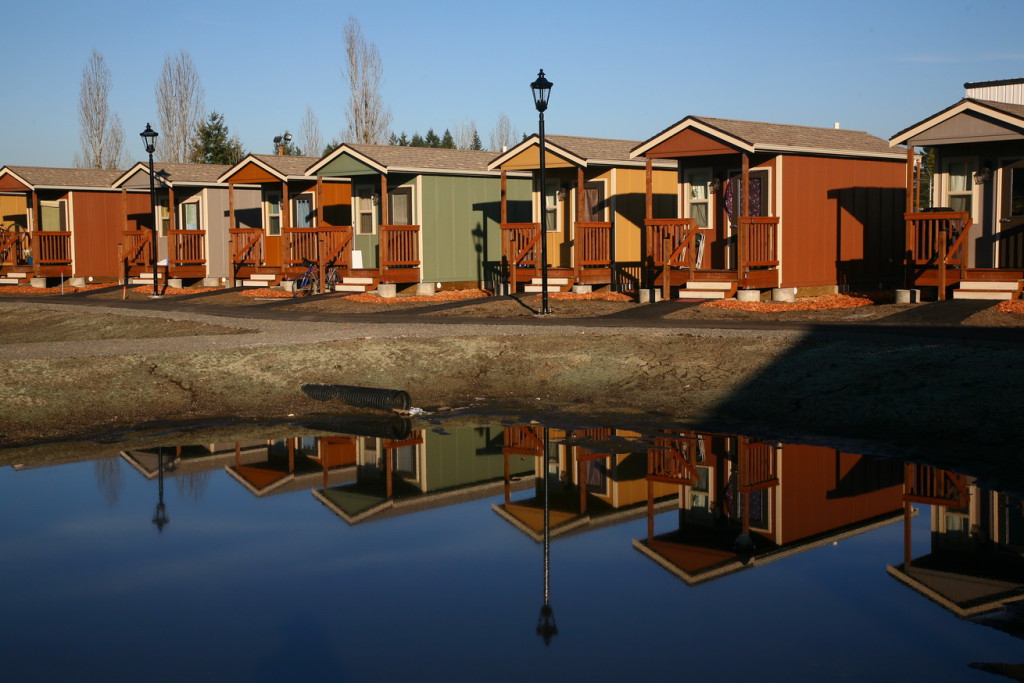Meet Elvis Summers. Elvis has a blue mohawk, lives in L.A. and found himself frequently running into a 60-year-old homeless woman named Irene McGhee–“Smokie” to her friends. Smokie would sleep in the dirt near his apartment complex and was always asking him for recyclables. Their brief but frequent interactions led eventually to friendship. Elvis learned that Smokie–a grandmother–had been on the streets for 10 years after losing her husband and then her home.
One day, Elvis read about the Tiny House Movement. Tiny houses are typically only between 100-400 square feet and are required to be on wheels since permanent housing of that size is usually illegal. Though the homes are diminutive, a lot is possible in a small space (see houses here). They represent a social movement of folks who reject conventional lifestyles for one that gives them more financial freedom and as a result, more free time. Many see these houses as a solution to environmental problems for a future in which resources become more and more limited.
Elvis realized that he could build a tiny house for Smokie, and that it would be financially feasible if he just put off paying a few bills for a while. After spending $500 on materials, getting a few more materials donated, and spending five days in manual labor, Elvis handed Smokie over the keys to her new pad. A home that is three and a half feet wide and eight feet long. It has a window and a door with two locks: Smokie said her first night sleeping in gave her security that she had been lacking for years. As she puts it, “It felt so good. I was so relaxed. I think I must’ve slept half of the day.” The LAPD are supportive of the project, so long as Smokie moves her home every 72 hours to avoid breaking the law: it is fitted with sturdy wheels for just that purpose.
Since receiving publicity for his act of kindness, Elvis has been contacted by other homeless people who would like him to build them a tiny house and has started a Go Fund Me Campaign to raise funds. His eventual goal is to raise $50,000 to build 100 homes and to find them a permanent location. In a little over two weeks, Elvis has raised $19,421 to build more houses for homeless folks. He believes the project is the human thing to do. As he puts it:
“Being homeless is not a crime. The true crime is how we as human beings look at and treat people [who] are homeless. Some people don’t, but most homeless people want help and are desperate to get off the streets. Many to most are losing hope or have already lost it and are simply dying, homeless and hungry.”
Elvis is not alone. Similar campaigns for tiny homes have sprung up around the country and many are beginning to see it as a viable solution to homelessness. In addition, several villages have been established including:
- Quixote Village in Olympia, WA
- OM Village in Madison, WI
- Community First! Village in Austin, TX
- Second Wind Cottages in Newfield, NY
- Opportunity Village in Eugene, OR
The villages typically use shared kitchens, bathrooms, large gathering spaces, and gardening areas to keep costs down, and they require residents to contribute to the upkeep of the community. Many of them are self-governing, democratic communities. The villages are often built on donated land and often with many donated materials. They really seem too good to be true, but they are real, and they are working to end homelessness.
Though this story begins with one guy who saw a woman in need—a grandmother sleeping on the ground—I think the message is clear: If we react to the people around us who are in need, we can see to it that they are no longer in need. And when we help each other out, the world only gets better for it. We all win.



Comments
I love this!!! Makes me want to build one for someone…